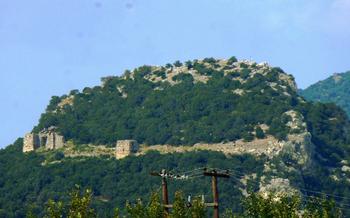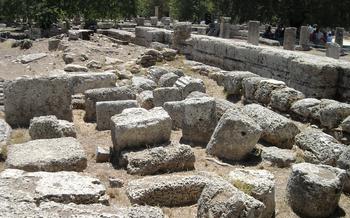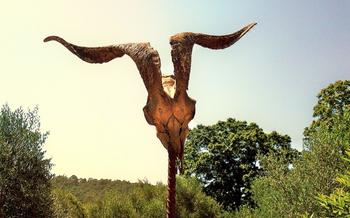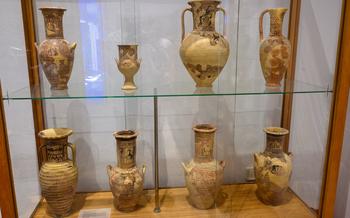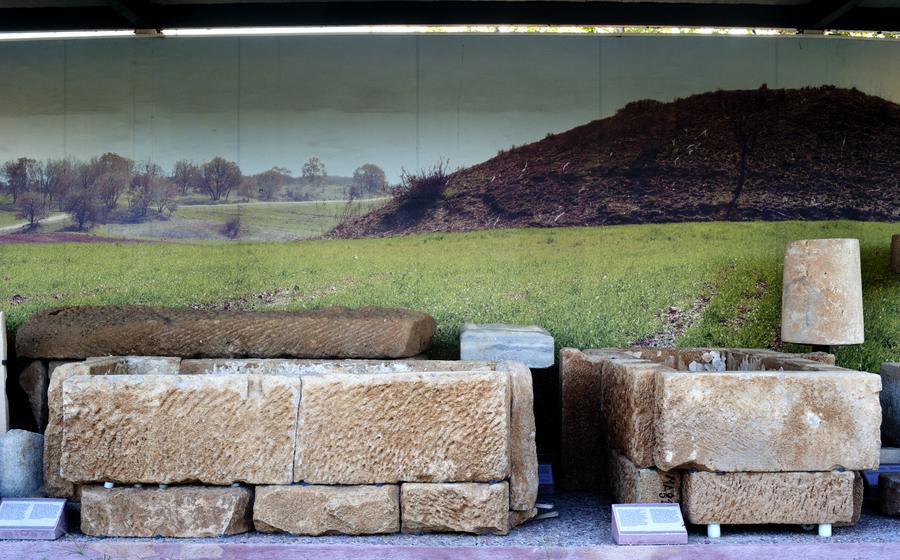
The Archaeological Site of Abdera
- The Archaeological Site of Abdera: A Journey Through History
- Unveiling the Ancient City: A Glimpse into Abdera's Past
- Exploring the Agora: The Heart of Abdera
- Temple of Apollo: A Place of Worship and Reverence
- The Theater of Abdera: A Stage for Ancient Performances
- The Walls of Abdera: A Symbol of Strength and Defense
- The Necropolis: A Silent City of the Dead
- The Museum of Abdera: A Treasure Trove of Ancient Artifacts
- Abdera and the Ionian Revolt: A Chapter in Greek History
- Abdera's Contribution to Philosophy and Science: A Legacy of Intellectual Thought
- Festivals and Events: A Celebration of Culture and Tradition
- Accommodation Options: A Range of Choices for Every Traveler
- Getting Around: Navigating Xanthi's Transportation System
- Insider Tip: Unveiling the Hidden Gem of Xanthi
The Archaeological Site of Abdera: A Journey Through History
Abdera, an ancient city in Thrace, Greece, holds a significant place in the annals of history. Founded in the 7th century BC by colonists from Clazomenae in Ionia, Abdera flourished as a center of commerce, culture, and philosophy. Its strategic location on the Aegean coast, at the mouth of the Nestos River, made it a vital trading hub and a gateway to the Balkans.
Reaching Abdera is a breeze, as it lies just 18 kilometers east of Xanthi, the capital of the Xanthi regional unit. Visitors can embark on a captivating journey through the ruins of this ancient city, where they'll encounter remnants of temples, theaters, walls, and other structures that evoke the grandeur of a bygone era. A visit to Abdera promises an immersive experience, transporting visitors back in time to witness the vibrancy and significance of this once-thriving metropolis.
To fully appreciate the wonders of Abdera, it's advisable to plan your trip during the spring or autumn months when the weather is pleasant and conducive to outdoor exploration. Ensure you wear comfortable shoes, as you'll be doing a fair amount of walking on uneven terrain. Don't forget to bring your camera to capture the stunning vistas and architectural marvels that await you. A visit to Abdera is not just a journey through history—it's an unforgettable adventure that will leave you in awe of the enduring legacy of this ancient Greek city.
Unveiling the Ancient City: A Glimpse into Abdera's Past
Abdera's founding and role in ancient Greece: Abdera was founded in the 7th century BC by colonists from Clazomenae, a city in Ionia. It quickly rose to prominence as a major commercial and cultural center in Thrace. Abdera's strategic location on the Aegean coast made it a vital trade hub, connecting Greece with the eastern Mediterranean and beyond.
Excavations and discoveries: Systematic excavations at the archaeological site of Abdera began in the late 19th century and have continued to the present day. These excavations have unearthed a wealth of artifacts and ruins that have shed light on the city's rich history and culture. Discoveries include well-preserved temples, theaters, agora, city walls, and a necropolis, providing valuable insights into Abdera's urban planning, architecture, and daily life.
Notable landmarks and structures: Among the most notable landmarks within the archaeological site are the Temple of Apollo, the Theater of Abdera, and the city walls. The Temple of Apollo, dedicated to the Greek god of music and prophecy, is a magnificent example of classical Greek architecture. The Theater of Abdera, with its well-preserved seating tiers, once hosted theatrical performances and public assemblies. The city walls, with their impressive gates and towers, demonstrate Abdera's strategic importance and its ability to withstand attacks.
Stories and legends: Abdera is associated with numerous stories and legends from ancient Greek mythology and history. It is said that the city was named after Abderus, a Thracian hero who was killed by Diomedes' horses. Another legend tells of the Abderite Democritus, a renowned philosopher who was known for his cheerful disposition and his theory of atoms. These stories and legends add to the charm and mystique of Abdera, making it a fascinating destination for history buffs and mythology enthusiasts.
Exploring the Agora: The Heart of Abdera
The agora, the central public space in ancient Greek cities, served as a bustling hub for commerce, politics, and social interaction. In Abdera, the agora was a particularly significant location, as evidenced by its prominent position within the city's layout.
The agora in Abdera featured a rectangular layout, surrounded by stoas or covered walkways. These stoas provided shelter from the sun and rain, creating a pleasant environment for people to gather and conduct their daily activities. Within the agora, there were numerous shops, where merchants sold a variety of goods, from pottery and textiles to food and spices.
The agora was also home to several temples and other public buildings. These structures served religious, administrative, and judicial purposes, further emphasizing the importance of the agora as a central gathering place for the citizens of Abdera.
One of the most notable features of the agora in Abdera is the well-preserved remains of a large cistern. This cistern, which was used to store water for the city's inhabitants, is a testament to the advanced engineering skills of the ancient Greeks.
A visit to the agora in Abdera offers a glimpse into the daily life of the ancient city's inhabitants. It is easy to imagine the bustling crowds of people, the lively conversations, and the vibrant atmosphere that once characterized this central public space.
Temple of Apollo: A Place of Worship and Reverence
In the heart of the ancient city of Abdera, the Temple of Apollo stands as a testament to the city's religious and cultural significance. Dedicated to the Greek god Apollo, the patron of music, poetry, and healing, the temple held a prominent place in the lives of Abdera's citizens.
Built in the 6th century BC, the Temple of Apollo showcased the architectural prowess of the ancient Greeks. Constructed from local marble, the temple featured a Doric order and a rectangular design. Its imposing columns and intricate carvings reflected the grandeur of the deity it honored.
As the central place of worship for Apollo, the temple served as a venue for religious ceremonies, rituals, and sacrifices. Devotees would gather within its sacred walls to seek Apollo's guidance, offer prayers, and express their gratitude. The temple also hosted festivals and celebrations in honor of the god, bringing the community together in joyous worship.
Excavations at the temple site have uncovered a wealth of artifacts and inscriptions that provide insights into the temple's history and significance. Among the discoveries are votive offerings, such as statues, pottery, and jewelry, left by worshippers seeking Apollo's favor. These offerings testify to the deep devotion and reverence felt by the people of Abdera towards their patron deity.
Today, the Temple of Apollo stands as a majestic ruin, yet it continues to captivate visitors with its grandeur and historical importance. Its presence evokes a sense of awe and reverence, transporting visitors back to a time when gods and goddesses were an integral part of daily life in ancient Greece.
The Theater of Abdera: A Stage for Ancient Performances
In the heart of the ancient city of Abdera, nestled amidst the ruins of temples and public buildings, lies the Theater of Abdera. This magnificent structure, carved into the natural hillside, served as a central venue for entertainment, cultural expression, and civic gatherings.
The theater's design reflects the architectural prowess of the ancient Greeks. Built in the 4th century BC, it features a well-preserved orchestra, or circular performance space, surrounded by tiers of stone seating. The seating is divided into wedge-shaped sections, known as kerkides, which could accommodate up to 5,000 spectators.
The stage building, or skene, is a particularly impressive feature of the Theater of Abdera. It consists of a long, rectangular structure with a central doorway and two side entrances. The skene's facade was likely adorned with elaborate decorations and served as a backdrop for theatrical performances.
The theater was not merely a place of entertainment; it also played a significant role in religious and civic life. During festivals honoring Dionysus, the god of theater and wine, plays and other performances were held at the theater. These events provided a platform for dramatists to showcase their works and for the community to come together in celebration.
The Theater of Abdera offers visitors a glimpse into the vibrant cultural life of ancient Greece. Its well-preserved state and stunning acoustics allow visitors to imagine the atmosphere of a live performance, where actors declaimed their lines and audiences cheered or jeered from the seating tiers.
Today, the Theater of Abdera stands as a testament to the enduring legacy of ancient Greek theater. It continues to host occasional performances and cultural events, allowing visitors to experience the magic of this ancient stage firsthand.
The Walls of Abdera: A Symbol of Strength and Defense
The strategic location of Abdera, situated on a hill overlooking the Aegean Sea, made it a prime target for invasions and attacks. To protect themselves from potential threats, the ancient Abderites constructed a formidable system of city walls. These walls, built with precision and strength, served as a testament to Abdera's resilience and determination to safeguard its people and prosperity.
The city walls were constructed using large blocks of stone, carefully fitted together without the use of mortar. They stood several meters high and were reinforced with towers and gates. The towers provided strategic vantage points for guards to keep watch over the surrounding area, while the gates allowed controlled access to and from the city.
The walls of Abdera not only served a defensive purpose but also played a crucial role in shaping the city's urban layout. They enclosed an area of approximately 50 hectares, within which the city's streets, buildings, and public spaces were organized. The walls also defined the boundaries of Abdera, separating it from the surrounding countryside.
The impressive remains of Abdera's city walls can still be seen today, standing as a testament to the engineering skill and strategic foresight of the ancient Abderites. Visitors can explore the various sections of the walls, marveling at their construction and imagining the bustling life that once took place within their protective embrace.
The Necropolis: A Silent City of the Dead
In ancient Greece, death and burial rituals held profound significance, and Abdera's necropolis offers a glimpse into these practices. Located outside the city walls, the necropolis served as the final resting place for Abdera's citizens. Its layout reflects the ancient Greek belief in an afterlife, with tombs arranged in orderly rows and streets.
The types of tombs found in the necropolis vary, showcasing the diverse social and economic status of Abdera's population. Simple pit graves, often used for infants and children, contrast with elaborate chamber tombs reserved for wealthy families. These chamber tombs feature multiple rooms and are adorned with intricate carvings and paintings, providing insights into the beliefs and customs of the ancient Abderites.
Artifacts discovered within the tombs shed further light on funerary practices. Grave goods such as pottery, jewelry, and tools were placed alongside the deceased to accompany them on their journey to the afterlife. Inscriptions on tombstones reveal personal details about the deceased, their families, and their hopes for the hereafter.
Exploring the necropolis offers a poignant glimpse into the lives and deaths of Abdera's ancient inhabitants. It's a place where history and archaeology intertwine, providing a profound understanding of the cultural and spiritual beliefs that shaped this ancient city.
The Museum of Abdera: A Treasure Trove of Ancient Artifacts
The Museum of Abdera, situated in the heart of Xanthi, serves as a repository of invaluable artifacts unearthed from the archaeological site. Established in 1954, the museum houses an impressive collection of sculptures, pottery, tools, and other objects that provide a glimpse into Abdera's rich past.
The museum's exhibits are arranged chronologically, taking visitors on a journey through Abdera's history from its foundation to its decline. Among the highlights of the collection are exquisite marble sculptures depicting gods and goddesses, finely crafted pottery adorned with intricate designs, and bronze tools that offer insights into the daily lives of Abdera's inhabitants.
Interactive displays and multimedia presentations enhance the museum experience, providing visitors with a deeper understanding of Abdera's culture, society, and economy. Through these interactive elements, visitors can virtually explore the ancient city, learn about its architectural wonders, and gain insights into the lives of its people.
The Museum of Abdera is a must-visit for anyone interested in ancient Greek history and archaeology. Its collection of artifacts, combined with its interactive exhibits, offers a comprehensive and engaging exploration of Abdera's past, making it a valuable resource for scholars and history enthusiasts alike.
Abdera and the Ionian Revolt: A Chapter in Greek History
Abdera played a significant role in the Ionian Revolt, a pivotal event in Greek history that marked the beginning of the Greco-Persian Wars.
The Ionian Revolt was an uprising of Greek cities in Ionia (modern-day Turkey) against the rule of the Persian Empire. The revolt began in 499 BC when the Ionian city of Miletus, supported by Athens and Eretria, attacked the Persian city of Sardis. The revolt quickly spread to other Ionian cities, including Abdera.
Abdera's involvement in the Ionian Revolt is mentioned by the ancient Greek historian Herodotus. According to Herodotus, Abdera provided ships and troops to the Ionian fleet that attacked Sardis. The Ionians were initially successful in capturing and burning Sardis, but the Persians eventually regained control of the city.
The Ionian Revolt was ultimately unsuccessful, but it had a profound impact on the course of Greek history. The revolt led to the first Persian invasion of Greece, which culminated in the Battle of Marathon in 490 BC. The Battle of Marathon was a decisive victory for the Greeks, and it marked the beginning of the end of Persian rule over Greece.
Abdera's participation in the Ionian Revolt is a testament to the city's importance in the ancient world.
The city's willingness to stand up to the Persian Empire, even though it was ultimately unsuccessful, shows that Abdera was a city of independent spirit and courage.
Abdera's Contribution to Philosophy and Science: A Legacy of Intellectual Thought
Abdera, beyond its historical significance and archaeological wonders, is also renowned for its intellectual legacy, which has left an enduring mark on Western thought. The city produced several notable philosophers and scientists who made significant contributions to various fields of knowledge.
One of the most prominent figures from Abdera was Democritus, a pre-Socratic philosopher and scientist known for his atomic theory. Democritus proposed that all matter is composed of tiny, indivisible particles called atoms, which move and interact in a void. This revolutionary idea laid the foundation for modern atomic theory and earned Democritus the title of the "Father of Modern Science."
Another notable Abderite was Anaxarchus, a philosopher who was a close friend and advisor to Alexander the Great. Anaxarchus was known for his stoic teachings and his emphasis on the importance of virtue and self-control. He accompanied Alexander on his campaigns and played a significant role in shaping the intellectual climate of the Hellenistic world.
In the field of mathematics, Abdera was home to Hippias, a versatile scholar who made important contributions to geometry, astronomy, and philosophy. Hippias was known for his ability to solve complex mathematical problems and for his skill in constructing intricate geometric figures. His work had a significant influence on the development of mathematics in ancient Greece.
These are just a few examples of the many intellectuals who hailed from Abdera, demonstrating the city's remarkable contribution to philosophy and science. Their ideas and theories had a profound impact on ancient Greek thought and continue to influence modern scientific and philosophical thought to this day.
Festivals and Events: A Celebration of Culture and Tradition
Xanthi comes alive with a vibrant calendar of festivals and events throughout the year, offering a unique opportunity to immerse yourself in local culture and traditions. The Xanthi Carnival, held annually in February or March, is a highlight not to be missed. This colorful celebration features elaborate parades, masquerade balls, and street parties, showcasing the city's infectious energy and creativity.
In May, the Xanthi International Short Film Festival takes center stage, attracting filmmakers and movie enthusiasts from around the world. Screenings, workshops, and discussions provide a platform for emerging talent and established filmmakers to showcase their work.
History buffs will delight in the Xanthi Medieval Festival, held in June or July. This festival transports visitors back in time to the Byzantine era, with historical reenactments, traditional music and dance performances, and a medieval market filled with authentic crafts and delicacies.
For those seeking a spiritual experience, the Xanthi Religious Music Festival in September offers a soul-stirring lineup of Byzantine and traditional Greek music performed in churches and monasteries throughout the city.
Plan your trip to Xanthi to coincide with one of these festivals and immerse yourself in the city's rich cultural heritage.
Accommodation Options: A Range of Choices for Every Traveler
Xanthi offers a diverse range of accommodation options to suit every traveler's needs and budget. From budget-friendly hostels and guesthouses to mid-range hotels and luxurious resorts, there's something for everyone.
For those on a tight budget, there are several hostels and guesthouses located in the city center. These offer basic but comfortable accommodation, often with shared bathrooms and communal areas. Prices typically start from around €15 per night for a bed in a dormitory room.
Mid-range hotels offer a more comfortable stay, with private rooms and en-suite bathrooms. These are a good option for those who want to be close to the city center but don't want to pay the high prices of luxury hotels. Prices for a double room typically start from around €40 per night.
For those who want to splurge, there are several luxury hotels in Xanthi that offer a truly unforgettable experience. These hotels often have stunning views of the city or the surrounding countryside, as well as a range of amenities such as swimming pools, spas, and fine dining restaurants. Prices for a double room typically start from around €100 per night.
When choosing an accommodation in Xanthi, it's important to consider your budget, your desired level of comfort, and your proximity to the city center. If you're on a tight budget, there are plenty of affordable options available. If you're looking for a more comfortable stay, there are several mid-range hotels to choose from. And if you want to splurge, there are several luxury hotels that will offer you an unforgettable experience.
Insider Tip: For a truly unique experience, consider staying in one of the many traditional guesthouses in Xanthi. These guesthouses are typically family-run and offer a warm and welcoming atmosphere. They're also a great way to learn about the local culture and traditions.
Getting Around: Navigating Xanthi's Transportation System
Xanthi offers a convenient and efficient transportation system to help you explore the city and its surroundings. The city is well-connected by public transportation, including buses and taxis. Buses are the most affordable option, with routes covering various parts of the city and surrounding areas. Taxis are readily available, providing a comfortable and direct mode of transportation, especially for short distances or late-night travel.
If you prefer a more flexible and independent way to explore, consider renting a car or bicycle. Car rental agencies are easily found in the city center, allowing you to travel at your own pace and explore the region's scenic countryside. Bicycles are also a popular option, offering a healthy and eco-friendly way to navigate the city's streets and discover hidden gems.
To plan your transportation effectively, it's advisable to obtain a map of Xanthi and familiarize yourself with the bus routes and taxi stands. You can also inquire at your hotel or tourist information centers for specific directions and recommendations. Remember to validate your bus tickets upon boarding and keep them until the end of your journey.
Insider Tip: For a unique and immersive experience, consider exploring Xanthi on foot. The city's compact center and charming pedestrianized streets invite you to stroll leisurely, discover hidden corners, and soak up the local atmosphere. Take advantage of the city's walkability to uncover hidden treasures and enjoy a more personal connection with Xanthi's vibrant culture.
Insider Tip: Unveiling the Hidden Gem of Xanthi
Amidst the many wonders of Xanthi, there lies a hidden gem that beckons the curious and adventurous traveler. Nestled in the heart of the city, the Old Town of Xanthi is a treasure trove of history, culture, and architectural wonders. Stroll along its cobblestone streets and marvel at the beautifully preserved Ottoman-era mansions, each adorned with intricate carvings and colorful facades.
Step into the Old Town's charming boutiques and shops, where you can find unique souvenirs and handicrafts that reflect the region's rich heritage. Stop by one of the traditional tavernas to savor authentic Greek cuisine while soaking in the lively atmosphere. As the sun sets, the Old Town transforms into a magical realm, with its narrow streets illuminated by flickering lanterns, creating an enchanting ambiance.
Venture beyond the main tourist spots and explore the hidden corners of the Old Town, where you'll discover secret gardens, secluded courtyards, and charming cafes tucked away from the bustling crowds. Take your time to wander through this atmospheric neighborhood, and you'll be rewarded with a glimpse into the authentic soul of Xanthi.
